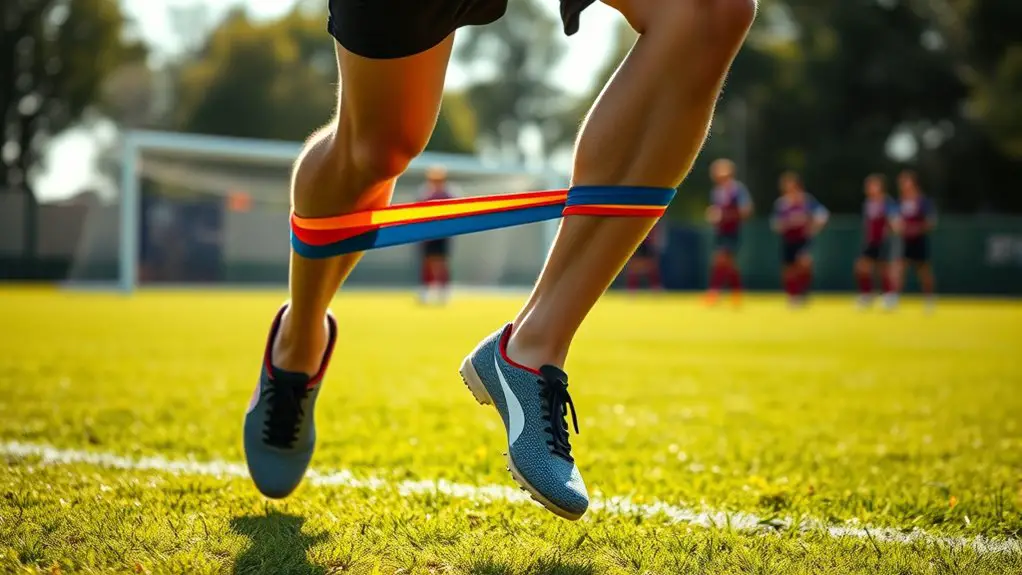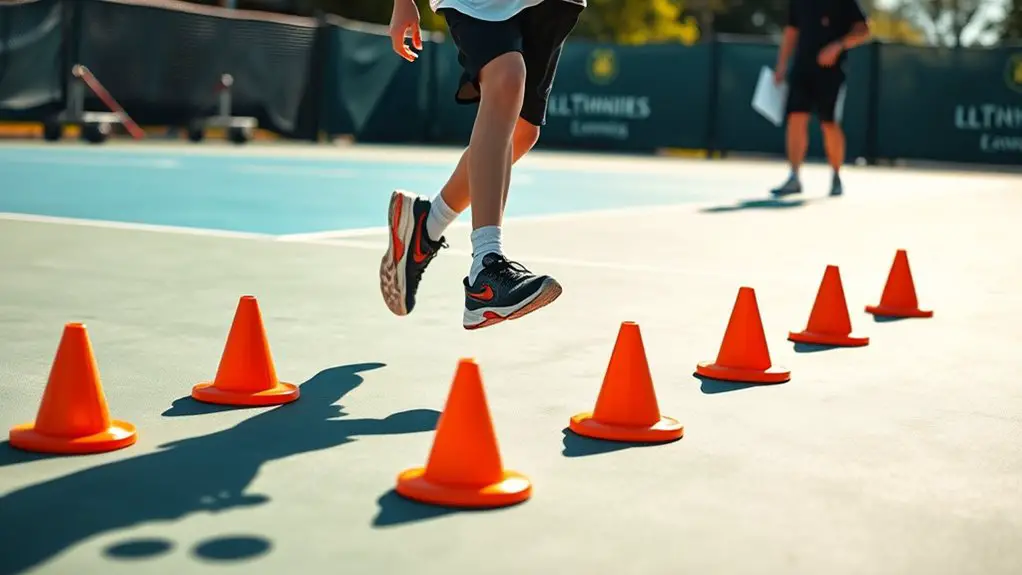To strengthen your shoulders for better serve accuracy, focus on key exercises that target your rotator cuff and deltoids. Incorporate resistance training, like shoulder presses and lateral raises, while also emphasizing flexibility and mobility through dynamic stretching. Consistency in your workouts will enhance stability and reduce injury risks. Remember to track your progress to stay motivated. By building a strong shoulder foundation, you'll improve your precision and power—there's more to discover for peak performance.
Understanding the Role of Shoulder Strength in Sports Performance
When you consider how critical shoulder strength is in sports, it becomes clear that it plays a pivotal role in overall performance. Strong shoulders enhance your ability to execute movements with precision, be it a powerful serve in tennis or a swift throw in baseball. Understanding shoulder biomechanics is essential; it allows you to grasp how various shoulder muscles and joints work together during athletic activities.
Engaging in targeted strength training not only builds muscle but also increases stability and flexibility, reducing injury risks. By focusing on exercises that promote functional strength, you empower your shoulders to handle dynamic movements more effectively. A well-rounded approach to shoulder strength can elevate your game, giving you the freedom to perform at your best. So, embrace the journey of strength training, and watch how it transforms your athletic performance, enabling you to achieve your goals with confidence and ease.
Key Muscles Involved in Shoulder Stability
Although many muscles contribute to overall shoulder stability, several key players stand out in maintaining joint integrity and function. The rotator cuff is crucial, as it consists of four muscles that work together to stabilize the shoulder joint during movement. Without a strong rotator cuff, you risk injury and instability, especially when serving.
The deltoid muscle also plays an important role, controlling the arm's position and allowing for powerful movements. Understanding these muscles can empower you to enhance your shoulder stability and serve accurately. A strong rotator cuff enables lifting, throwing, and daily tasks without limitation.
| Muscle | Function |
|---|---|
| Rotator Cuff | Stabilizes shoulder joint |
| Deltoid | Facilitates arm movement |
| Infraspinatus | External rotation of the arm |
Focusing on these muscles will help you improve your overall shoulder strength and performance on the court. Remember, a stable shoulder leads to better serve accuracy!
Essential Shoulder Exercises for Athletes
To enhance your shoulder strength and serve accuracy, it's important to focus on specific exercises. You'll want to incorporate rotator cuff strengthening techniques, shoulder mobility drills, and resistance band exercises into your routine. These essential moves can help you build a solid foundation for peak performance.
Rotator Cuff Strengthening Techniques
Rotator cuff strengthening techniques are essential for athletes looking to enhance their serve accuracy and overall shoulder stability. Focusing on rotator cuff strength training helps you build the necessary support for your shoulder, allowing for more powerful and precise serves. Start with external rotations using resistance bands to target the infraspinatus and teres minor. Incorporate internal rotations to engage the subscapularis, and don't forget about the overhead press for overall shoulder power. Scapular retraction exercises, like rows, can also strengthen the surrounding muscles. Remember, consistency is key; aim for 2-3 sessions a week. By committing to these rotator cuff exercises, you'll pave the way for improved performance and reduced injury risk on the court.
Shoulder Mobility Drills
While strengthening your rotator cuff is essential, improving shoulder mobility is equally important for enhancing serve accuracy. Incorporating shoulder stretches into your routine can make a significant difference in your overall performance. Start with dynamic mobility routines like arm circles and cross-body stretches to loosen up those tight muscles. You can also try doorway stretches to open up your chest and improve your range of motion. Remember, the more mobile your shoulders are, the better control you'll have during your serves. Consistency is key, so integrate these exercises into your training sessions regularly. With enhanced mobility, you'll experience greater freedom in your movements, allowing you to serve with precision and confidence on the court.
Resistance Band Exercises
Incorporating resistance band exercises into your training can greatly enhance shoulder strength and stability, both essential for athletes aiming for serve accuracy. These exercises improve band resistance and shoulder endurance, allowing you to perform at your best.
| Exercise | Description |
|---|---|
| External Rotation | Secure band, rotate arm outward. |
| Internal Rotation | Secure band, rotate arm inward. |
| Lateral Raises | Stand on band, lift arms to the side. |
| Front Raises | Stand on band, lift arms forward. |
| Reverse Flyes | Bend slightly, pull band outwards. |
Engaging in these resistance band exercises will not only strengthen your shoulders but will also help maintain their flexibility, giving you the freedom to serve with precision.
Incorporating Resistance Training for Shoulder Strength
To enhance your shoulder strength for improved serve accuracy, resistance training plays an essential role. By incorporating various resistance techniques, you can build the necessary strength to support peak shoulder mechanics during your serve. Start with exercises like shoulder presses, lateral raises, and external rotations, using dumbbells or resistance bands. These movements target the key muscles around your shoulder, promoting stability and power.
Don't forget to maintain proper form; this guarantees you're engaging the right muscles and reducing injury risk. Gradually increase resistance as you get stronger, but listen to your body—progress at your own pace. Remember, consistency is key; aim to include resistance training in your routine a few times a week. As you strengthen your shoulders, you'll notice improvements not just in serve accuracy, but in overall performance on the court. Additionally, incorporating Olympic lifts can further enhance your explosive strength, benefiting your serve. Embrace this journey, and watch your game elevate to new heights!
Importance of Flexibility and Mobility in the Shoulders
Flexibility and mobility in your shoulders are essential for improving your range of motion and overall serve accuracy. By incorporating these aspects into your training, you can also reduce the risk of injuries that often come with repetitive overhead movements. Let's explore how enhancing shoulder flexibility can benefit your performance on the court.
Enhanced Range of Motion
A well-rounded shoulder routine can greatly enhance your range of motion, which is essential for executing an accurate serve. When you focus on dynamic stretching, you're not just warming up; you're actively improving joint mobility and flexibility. This freedom of movement allows your shoulder to reach its full potential, helping you achieve that perfect serve with ease. Incorporating exercises that promote flexibility will enable you to swing your arm freely, generating power without compromising form. Plus, greater range means you can adjust your position with confidence, adapting to different serves. Embrace the journey to improved shoulder mobility, and enjoy the liberating feeling of enhanced performance on the court. Your serves will thank you for it!
Injury Prevention Strategies
Improving your shoulder's range of motion not only enhances your serve but also plays a significant role in injury prevention. By focusing on flexibility and mobility, you can optimize shoulder biomechanics and reduce your injury risk. Regular stretching and dynamic warm-ups keep your shoulders limber and ready for action.
| Strategy | Benefits | Frequency |
|---|---|---|
| Dynamic Stretching | Enhances mobility | Before practice |
| Static Stretching | Improves flexibility | After workouts |
| Strength Training | Supports shoulder stability | 2-3 times a week |
Embrace these strategies to maintain your shoulder health. A well-prepared shoulder can mean the difference between a powerful serve and a painful setback. Don't let injuries hold you back; take charge of your training!
Developing a Balanced Workout Routine
While you might be enthusiastic to jump into shoulder strengthening exercises, developing a balanced workout routine is vital for enhancing your serve accuracy. A well-rounded approach includes not only shoulder exercises but also core and leg workouts. This balance guarantees you're building overall strength and flexibility, which is essential for an effective serve.
Don't forget about the cross training benefits. Mixing in activities like swimming or yoga can improve your shoulder stability and overall athleticism, giving you the freedom to move more fluidly on the court. Incorporating functional strength training can further enhance your performance by focusing on movement patterns that mimic your sport's demands.
Additionally, a focus on balanced nutrition will fuel your workouts and recovery. Eating a variety of nutrient-dense foods supports muscle growth and energy levels, making it easier to stick to your routine. By incorporating these elements into your training, you'll not only strengthen your shoulders but also enhance your overall performance, leading to greater serve accuracy and satisfaction in your game.
Injury Prevention Strategies for Shoulder Health
To maintain shoulder health and prevent injuries, it's important to incorporate specific strategies into your training routine. Focus on proper shoulder ergonomics during your workouts and daily activities. This means being mindful of your posture and alignment, which can greatly reduce strain on your shoulder joint. Warm up adequately before any intense exercise, as this prepares your muscles and joints for action and helps prevent injuries.
Incorporate strength training that targets your rotator cuff and shoulder stabilizers; these muscles play a critical role in shoulder stability. Also, don't forget to prioritize flexibility exercises to enhance your range of motion and reduce tightness. Engaging in dynamic stretches as part of your warm-up routine can further enhance your shoulder health.
Listen to your body; if you experience discomfort, take a step back and allow for injury recovery. Rest and recovery are essential to maintaining shoulder health and ensuring you're ready for your next session. Embrace these strategies, and you'll feel empowered to move freely and serve accurately.
Progress Tracking: Measuring Your Shoulder Strength Gains
Tracking your shoulder strength gains is an essential part of your training process, especially after implementing injury prevention strategies. You want to make certain that your efforts are translating into real progress. One effective way to measure your gains is by using progress metrics, such as the weight you can lift or the number of repetitions you can perform with proper form.
Keep a training log to document these metrics regularly, noting any improvements or setbacks. This not only holds you accountable but also allows you to see how your shoulder strength evolves over time.
Additionally, consider incorporating functional assessments, like your serve accuracy or how your shoulder feels during practice. These insights can help you fine-tune your workouts and focus on areas needing improvement. Remember, progress isn't always linear, but by tracking your shoulder strength gains, you'll be better equipped to achieve the freedom and accuracy you desire in your serves. Developing grip strength can also enhance your overall shoulder stability, which is crucial for effective serving.
Tips for Maintaining Shoulder Strength Throughout the Season
As you navigate through the season, maintaining your shoulder strength is essential for ideal performance and injury prevention. Start each training session with effective shoulder warm ups to increase blood flow and flexibility. Incorporate dynamic stretches and resistance exercises that target your rotator cuff and deltoids.
Pay attention to your body and make seasonal adjustments to your routine as needed. If you notice any signs of fatigue or strain, don't hesitate to modify your workouts. Consistency is key, so try to incorporate shoulder exercises at least two to three times a week, even during lighter training phases. Including exercises that emphasize shoulder stability can further enhance your performance and reduce the risk of injury.
Listen to your body and prioritize rest when necessary, as overuse can lead to injuries. Finally, consider cross-training with activities that promote overall shoulder stability, like swimming or yoga. With these tips, you'll keep your shoulders strong and resilient, ensuring you stay at the top of your game throughout the season.
Frequently Asked Questions
How Long Does It Take to See Shoulder Strength Improvements?
Like a bird learning to soar, your shoulder's journey to strength takes time and patience. You might notice improvements within a few weeks, but don't be surprised if you hit a strength plateau along the way. Consistent training and proper shoulder recovery are key. Stay committed, and you'll find your wings. Embrace the process, as every small gain leads to greater freedom and control in your movements. Your efforts will pay off!
Can Shoulder Strength Affect My Performance in Other Sports?
Absolutely, shoulder strength can greatly impact your performance in various sports. When your shoulders have good stability, it enhances your overall athletic performance by allowing for better control and power in movements. Whether you're swinging a racket, throwing a ball, or lifting weights, strong shoulders provide the support you need. So, if you want to elevate your game and enjoy more freedom in your movements, focusing on shoulder strength is definitely worthwhile.
What Common Mistakes Should I Avoid When Training My Shoulders?
When training your shoulders, you should avoid a few common mistakes to keep things effective and enjoyable. First, don't let poor form creep in; it can lead to injury and hinder progress. Second, be careful not to overtrain—your shoulders need time to recover just like any other muscle group. Listen to your body, and give yourself freedom to rest when necessary. This way, you'll build strength without sacrificing your well-being.
How Often Should I Train My Shoulders Each Week?
You might think training your shoulders every day is the key, but hold on—what if I told you that's not the best approach? Finding the right shoulder training frequency is essential. Aim for two to three sessions per week, allowing for ideal recovery. This way, you'll build strength without risking injury or burnout. Balance is freedom, and with the right plan, your shoulders will transform in no time. Ready to release that potential?
Should I Warm up Before Shoulder Workouts, and How?
Absolutely, you should warm up before shoulder workouts! Incorporating dynamic stretching is essential for enhancing shoulder mobility and preparing your muscles. Try arm circles, shoulder dislocates with a band, or torso twists to get your blood flowing and joints ready. This way, you'll reduce the risk of injury and improve your performance. Remember, taking a few minutes to warm up can make a big difference in how you feel during your workout!




